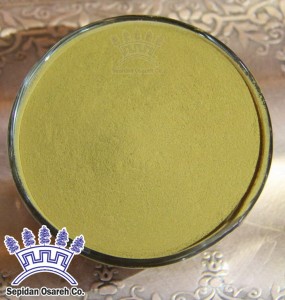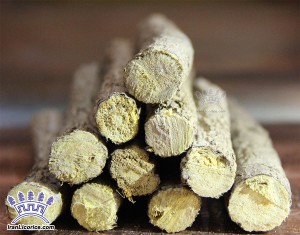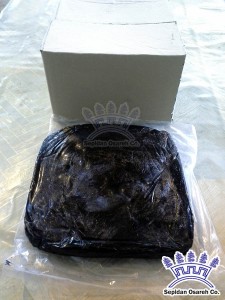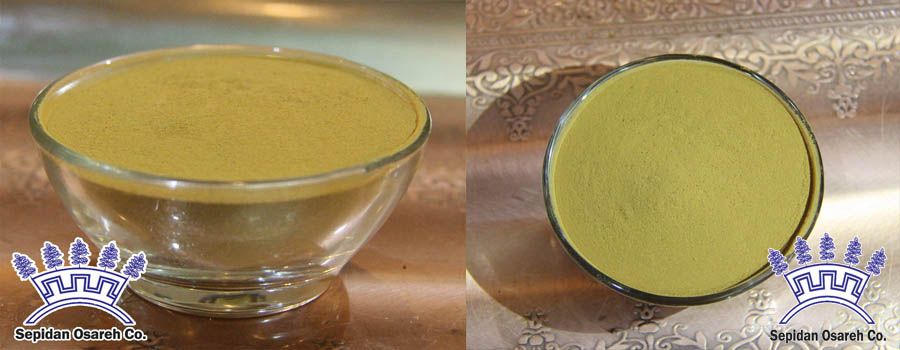Deglycyrrhizinated Licorice ( Licorice DGL )

We Produce Licorice Extract Powder , Blocks , Liquid Paste , DGL & more to all over the world.
| Technical Name: | (Glycyrrhiza Glabra) Dried roots, whole extracts and “deglycyrrhizinated” extracts |
| Used for: | Deglycyrrhizinated licorice (DGL) for chronic indigestion, heartburn, stomach ulcers, canker sores; whole licorice extract for menstrual and menopausal disorders and inflammatory disorders; topical whole licorice for herpes, eczema, psoriasis |
| Available In: | Whole licorice as roots, extracts, and topical preparations; DGL as chewable tablets, wafers, capsules, tea and powder. |
| Herb Drug: | Licorice products that still contain the glcyrrhizing and whole licorice taken orally may increase the effects of corticosteroids, cause sodium and water retention and increase blood pressure, increase the effect of digitalis preparations, alter the effect of estrogens/progesterone and decrease the effect of anti-hypertensives. No known interactions with DGL. |
| Interaction: | Avoid whole licorice or licorice root if you have high blood pressure, kidney or liver disease, diabetes or heart disease, if you’re using diuretics, and during pregnancy. No side effects for DGL. Do not take licorice root for longer than six weeks. |
| When Buying: | 6-10% glycyrrhizin. |
| Dosage and Warning: | Follow dosage instructions accompanying whole licorice products. If using DGL extract, take two tablets chewed slowly before or between meals or one half teaspoon of the powder at the same times. DGL powder can be made into a paste or mouthwash (swish in mouth for three minutes and spit) to treat mouth ulcers. |
| Child Dosage: | Half the adult dosage for both whole and DGL forms |
Deglycyrrhizinated licorice, or DGL, is an herbal supplement typically used in the treatment of gastric and duodenal ulcers. It is made from licorice from which the glycyrrhizin has been removed.
Deglycyrrhizinated liquorice plus antacid is marketed in Europe, South Africa, and Canada, as the medicinal preparation Caved-S. In the United States, DGL is marketed as an herbal supplement.
Research
Glycyrrhizin is known to cause negative side effects, such as hypertension and edema; removing the glycyrrhizin is meant to avoid these symptoms.
According to MedlinePlus and the Natural Medicines Comprehensive Database, licorice is “possibly effective” for dyspepsia in combination with other herbs, but there is “insufficient evidence” to rate its effectiveness for other conditions. Regarding stomach ulcers, specifically, there is “some evidence…that specially prepared licorice will speed the healing of stomach ulcers”.
An un-blinded study of 82 patients from the early 1980s, published in the British Medical Journal, reported that Caved-S had a therapeutic effect similar to that of cimetidine in the treatment of gastric ulcers.

Overview
Licorice (Glycyrrhiza glabra) has been used in food and as medicine for thousands of years. Also known as “sweet root,” licorice root contains a compound that is about 50 times sweeter than sugar. Licorice root has been used in both Eastern and Western medicine to treat a variety of illnesses, ranging from the common cold to liver disease. It acts as a demulcent, a soothing, coating agent, and as an expectorant, meaning it helps get rid of phlegm. It is still used today for several conditions, although not all its uses are supported by scientific evidence.
Licorice that has the active ingredient of glycyrrhiza can have serious side effects. Another type of licorice, called DGL or deglycyrrhizinated licorice, doesn’t seem to have the same side effects and is sometimes used to treat peptic ulcers, canker sores, and reflux (GERD). Whole licorice is still sometimes suggested for cough, asthma, and other breathing problems. Topical preparations are used for eczema and other skin problems.
Plant Description
Licorice grows wild in some parts of Europe and Asia. A perennial that grows 3 – 7 feet high, licorice has an extensive branching root system. The roots are straight pieces of wrinkled, fibrous wood, which are long and cylindrical (round) and grow horizontally underground. Licorice roots are brown on the outside and yellow on the inside. Licorice supplements are made from the roots and underground stems of the plant.

Medicinal Uses and Indications
Licorice root is often used for a variety of conditions.
Peptic ulcers
Deglycyrrhizinated licorice (DGL) is often suggested as a treatment for stomach ulcers, although there’s only mixed evidence about whether it works. A few studies have found that DGL and antacids helped treat ulcers as well as some prescription drugs. However, since antacids were combined with DGL, it’s not possible to know how much of the benefit came from DGL alone.
One animal study found that aspirin coated with licorice reduced the number of ulcers in rats by 50%. (High doses of aspirin often cause ulcers in rats.) In one study, licorice root fluid extract was used to treat 100 patients with stomach ulcers — 86 of whom had not improved with conventional medication — for 6 weeks. Ulcers disappeared in 22 people; 90% of participants got better. Other studies have found that DGL had no effect on peptic ulcers in humans.
Canker sores (Apthous ulcers)
One small study found that people with canker sores who gargled 4 times per day with DGL dissolved in warm water found pain relief.
Eczema
In one study, licorice gel, applied to the skin, helped relieve symptoms of itching, swelling, and redness. A gel with 2% licorice worked better than a gel with 1% licorice.
Dyspepsia (indigestion, GERD)
Some preliminary studies suggest that a specific herbal formula containing licorice, called Iberogast or STW 5, may help relieve symptoms of indigestion or GERD. This herbal formula also contains peppermint and chamomile, two herbs often used for indigestion.
Upper respiratory infections (cold, cough)
Licorice is a traditional treatment for cough and asthma. Studies have shown mixed results as to whether it works.
Weight loss
One study found that a preparation of licorice may reduce body fat. Fifteen people of normal weight consumed 3.5 g of licorice each day for 2 months. Body fat was measured before and after treatment. Licorice appeared to reduce body fat mass and to suppress the hormone aldosterone; however, the people in the study retained more water.
Another study found that a topical preparation of glycyrrhetinic acid (a component of licorice) reduced the thickness of fat on the thigh in human subjects. A third study found that people who took 900 mg of licorice flavonoid oil daily for 8 weeks had decreases in body fat, body weight, body mass index, and LDL cholesterol levels. More studies are needed to say if licorice really helps reduce fat. In addition, taking licorice long term has a number of health risks.
Other
People who regularly take large amounts of licorice — more than 20 g/day — may raise blood levels of the hormone aldosterone, which can cause serious side effects, including headache, high blood pressure, and heart problems. For people who already have high blood pressure or heart or kidney disease, as little as 5 g/day can cause these side effects. Further studies are needed.

Available Forms
Licorice products are made from peeled and unpeeled dried root. There are powdered and finely cut root preparations made for teas, tablets, and capsules, as well as liquid extracts. Some licorice extracts do not contain glycyrrhizin. These extracts are known as deglycyrrhizinated licorice (DGL), and do not seem to have the undesired side effects of other forms of licorice. Some studies suggest DGL may be better for stomach or duodenal ulcers. DGL may offer protection against ulcer formation when taken with aspirin.
How to Take It
Pediatric
Older children who have a sore throat can chew a piece of licorice root or drink licorice tea. Ask your doctor to help you determine the right dose for your child. Don’t give a child licorice tea for more than a day without talking to your doctor. Never give any licorice tea to an infant or toddler.
Adult
Licorice can be taken in the following forms:
-
Dried root: 1 – 5 g as an infusion or decoction (boiled), 3 times daily
-
Licorice 1:5 tincture: 2 – 5 mL, 3 times daily
-
Standardized extract: 250 – 500 mg, 3 times daily, standardized to contain 20% glycyrrhizinic acid
-
DGL extract: 0.4 – 1.6 g, 3 times daily, for peptic ulcer
-
DGL extract 4:1: chew 300 – 400 mg, 3 times daily 20 minutes before meals, for peptic ulcer
Don’t use these doses of licorice for longer than a week without talking to your doctor due to the risk of potentially dangerous side effects.
Precautions
The use of herbs is a time honored approach to strengthening the body and treating disease. Herbs, however, contain components that can trigger side effects and that can interact with other herbs, supplements, or medications. For these reasons, you should take herbs with care, preferably under the supervision of a health care provider in the field of botanical medicine.
Licorice with glycyrrhizin may cause serious side effects. Too much glycyrrhizin causes a condition called pseudoaldosteronism, which can cause a person to become overly sensitive to a hormone in the adrenal cortex. This condition can lead to headaches, fatigue, high blood pressure, and even heart attacks. It may also cause water retention, which can lead to leg swelling and other problems.
Although the most dangerous effects mostly happen with high doses of licorice or glycyrrhizin, smaller amounts of licorice may cause side effects. Some people have muscle pain or numbness in the arms and legs. To be safe, ask your health care provider to monitor your use of licorice.
People with the following conditions should not take licorice:
-
Heart failure
-
Heart disease
-
Hormone-sensitive cancers, such as breast, ovarian, uterine, or prostate cancer
-
Fluid retention
-
High blood pressure (hypertension)
-
Diabetes
-
Kidney disease
-
Liver disease
-
Low potassium (hypokalemia)
-
Erecetile dysfunction
Pregnant or breastfeeding women should not take licorice.
Don’t use any licorice product for longer than 4 – 6 weeks.
Possible Interactions
Licorice may interfere with several medications, including the ones listed below. If you are taking any medication, ask your doctor before taking licorice.
-
ACE inhibitors and diuretics — If you are taking angiotensin converting enzyme (ACE) inhibitors or diuretics for high blood pressure, you should not use licorice products. Licorice could cause these medications to not work as well or could make side effects worse, including a build-up of potassium in the body. ACE inhibitors include:
-
Captopril (Capoten)
-
Benazepril (Lotensin)
-
Enalapril (Vasotec)
-
Lisinopril (Prinivil, Zestril)
-
Gosinopril (Monopril)
-
Ramipril (Altace)
-
Perindopril (Aceon)
-
Quinapril (Accupril)
-
Moexipril (Univasc)
-
Trandolapril (Mavik)
-
-
Digoxin — Because licorice may dangerously increase the risk of toxic effects from digoxin, do not take this herb with this medication.
-
Corticosteroids — Licorice may increase the effects of corticosteroid medications. Talk to your doctor before using licorice with any corticosteroids.
-
Insulin or drugs for diabetes — Licorice may have an effect on blood sugar levels.
-
Laxatives — Licorice may cause potassium loss in people taking stimulant laxatives.
-
MAO inhibitors — Licorice may make the effects of this class of antidepressant stronger.
-
Oral contraceptives — There have been reports of women developing high blood pressure and low potassium levels when they took licorice while on oral contraceptives.
-
Warfarin (Coumadin) — Licorice may decrease the levels of this blood-thinner in the body, meaning it may not work as well.
-
Medications processed by the liver — Licorice may interfere with several medications processed by the liver, including celecoxib (Celebrex), diclofenac (Voltaren), fluvastatin (Lescol), glipizide (Glucotrol), ibuprofen (Advil, Motrin), phenytoin (Dilantin), piroxicam (Feldene), phenobarbital, and secobarbital (Seconal).

[fancy_images]
[image title=”Licorice DGL” alt=”Licorice DGL” caption=”Licorice DGL”]https://www.world-licorice.com/wp-content/uploads/2015/05/powder_licorice.jpg[/image]
[/fancy_images]
Licorice DGL ( Best Quality )
More Information :[fancy_link link=”www.IranLicorice.com” variation=”red” target=”blank”]www.IranLicorice.com[/fancy_link]
Related Links:
[fancy_link link=”http://licorice-liquorice.com/liquorice/liquorice-licorice/” target=”blank”]http://licorice-liquorice.com/liquorice/liquorice-licorice/[/fancy_link]
[fancy_link link=”http://licoriceproducts.com/licorice/glycyrrhiza-glabra/” target=”blank”]http://licoriceproducts.com/licorice/glycyrrhiza-glabra/[/fancy_link]
[fancy_link link=”http://rootlicorice.com/licorice/” target=”blank”]http://rootlicorice.com/licorice/[/fancy_link]
[fancy_link link=”http://rootlicorice.com/licorice/licorice-root/” target=”blank”]http://rootlicorice.com/licorice/licorice-root/[/fancy_link]
[fancy_link link=”http://licorice-powder.com/licorice/” target=”blank”]http://licorice-powder.com/licorice/[/fancy_link]
[fancy_link link=”http://www.licoriceherbs.com/licorice/licorice-herbs/” target=”blank”]http://www.licoriceherbs.com/licorice/licorice-herbs/[/fancy_link]
[fancy_link link=”http://best-quality-licorice.com/licorice/” target=”blank”]http://best-quality-licorice.com/licorice/[/fancy_link]
[fancy_link link=”http://liquorice.ir/%d8%b4%db%8c%d8%b1%db%8c%d9%86-%d8%a8%db%8c%d8%a7%d9%86/” target=”blank”]Shirin Bayan, Persian Language[/fancy_link]
